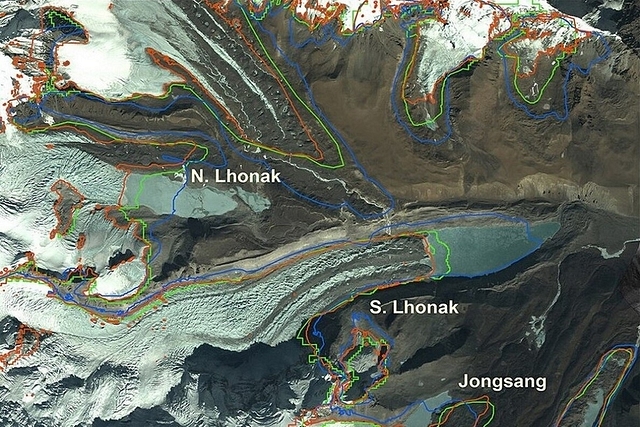News Brief
Sikkim Flash Floods: Glacial Lake Tripled In Size Over Three Decades Before Catastrophic Burst, Says Research Paper

Close up view of North Sikkim’s South Lhonak Glacial Lake. (Wikipedia)
North Sikkim’s South Lhonak glacial lake, at the center of the recent devastating flash flood, had been rapidly growing over the past 30 years, increasing from 0.42 sq km to 1.35 sq km, as per reports by The Times Of India.
By 2019, it held 65 million cubic feet of water, posing a significant risk of a glacial lake outburst flood (GLOF), which ultimately caused the destructive flood downstream.
Ashim Sattar, a researcher at the Indian Institute of Science's Divecha Centre for Climate Change in Bengaluru, had previously warned about the increasing danger posed by the South Lhonak lake in a paper published in 2021.
This study had identified various risk factors, including the lake's expansion towards steep slopes and its location in a seismic zone, making it more prone to landslides and avalanches.
When glaciers melt, the water accumulates in lakes, and breaches in natural barriers or avalanches can lead to sudden outbursts.
Sattar's study revealed that 70 per cent of glacial lakes in the Hindukush Himalayas are susceptible to landslide and avalanche-related incidents.
A study published last year raises concerns about the potential risks faced by over 650 hydropower projects located near glaciers or in areas prone to lake bursts.
Many of these projects are situated upslope from existing ones and close to glaciers and glacial lakes, highlighting the need for careful consideration and evaluation during the planning and construction of such projects.
Farooq Azim, a glaciologist at IIT Indore, explains that the disaster serves as an illustration of a "cascading hazard."
Specifically, a cloudburst or avalanche, coupled with a GLOF, resulted in the breach of a dam and subsequent flooding of the area.
The death toll from the recently occured Sikkim flash flood has reached 14, with over 100 individuals still missing, including 22 army personnel.
Azim emphasises that this is a prime example of one hazard triggering another hazard, highlighting the complex and interconnected nature of natural disasters in the region.
Support Swarajya's 50 Ground Reports Project & Sponsor A Story
Every general election Swarajya does a 50 ground reports project.
Aimed only at serious readers and those who appreciate the nuances of political undercurrents, the project provides a sense of India's electoral landscape. As you know, these reports are produced after considerable investment of travel, time and effort on the ground.
This time too we've kicked off the project in style and have covered over 30 constituencies already. If you're someone who appreciates such work and have enjoyed our coverage please consider sponsoring a ground report for just Rs 2999 to Rs 19,999 - it goes a long way in helping us produce more quality reportage.
You can also back this project by becoming a subscriber for as little as Rs 999 - so do click on this links and choose a plan that suits you and back us.
Click below to contribute.
Latest